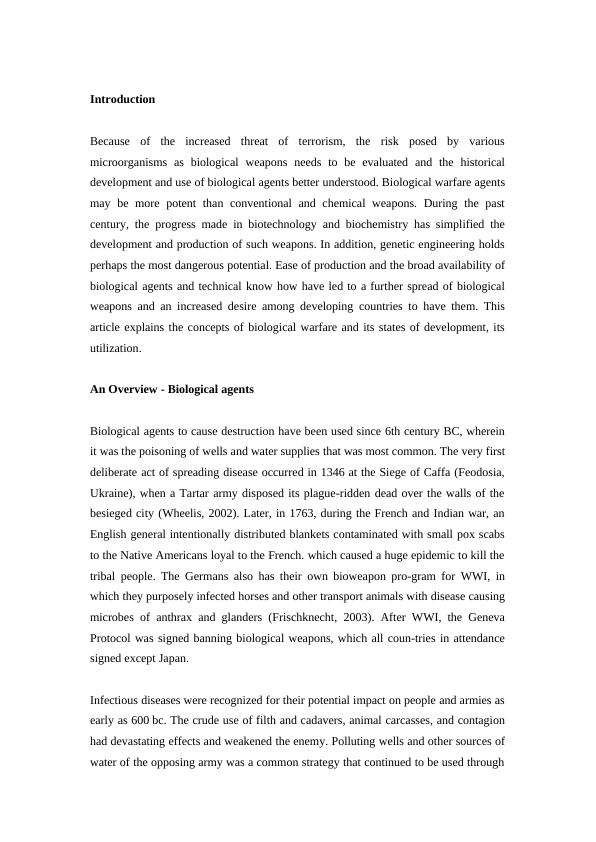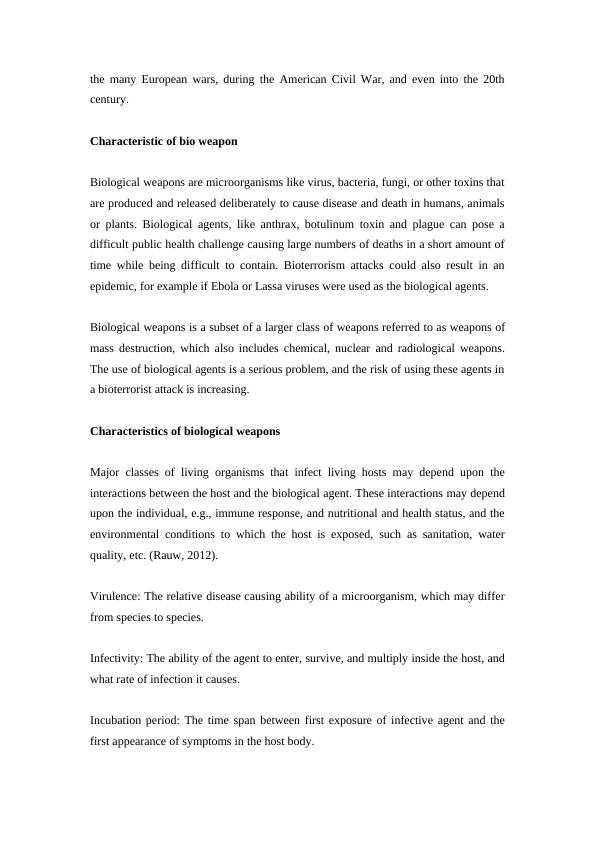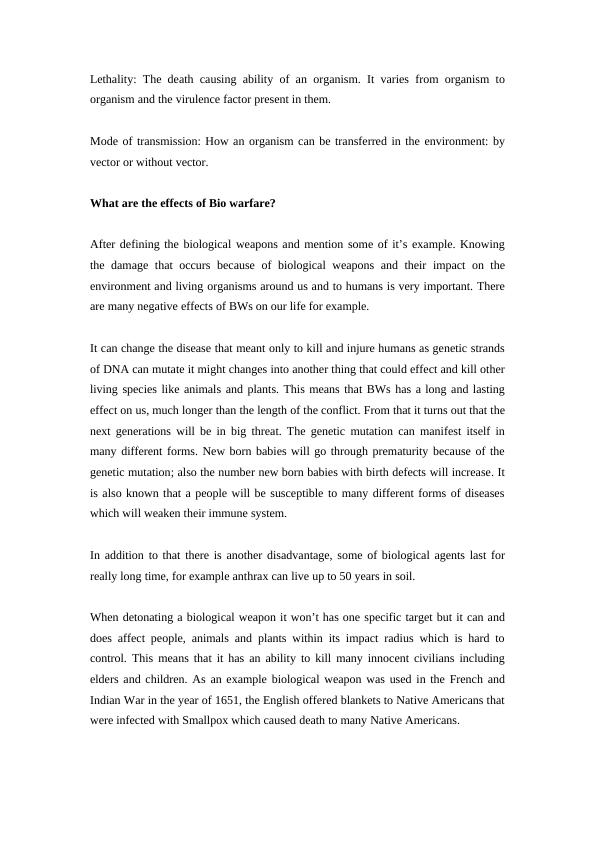Ask a question from expert
Biological Warfare: Concepts and Utilization
11 Pages3520 Words276 Views
Added on 2021-07-13
About This Document
This article explains the concepts of biological warfare and its states of development, its utilization, and the characteristics of bio weapons. It also discusses the effects of bio warfare, bioweapon threats, and the impact of microbes on climate change. Additionally, it provides information on how to prevent or counter the virus and vaccine response to bioweapon threats.
Biological Warfare: Concepts and Utilization
Added on 2021-07-13
BookmarkShareRelated Documents
IntroductionBecause of the increased threat of terrorism, the risk posed by variousmicroorganisms as biological weapons needs to be evaluated and the historicaldevelopment and use of biological agents better understood. Biological warfare agentsmay be more potent than conventional and chemical weapons. During the pastcentury, the progress made in biotechnology and biochemistry has simplified thedevelopment and production of such weapons. In addition, genetic engineering holdsperhaps the most dangerous potential. Ease of production and the broad availability ofbiological agents and technical know how have led to a further spread of biologicalweapons and an increased desire among developing countries to have them. Thisarticle explains the concepts of biological warfare and its states of development, itsutilization.An Overview - Biological agentsBiological agents to cause destruction have been used since 6th century BC, whereinit was the poisoning of wells and water supplies that was most common. The very firstdeliberate act of spreading disease occurred in 1346 at the Siege of Caffa (Feodosia,Ukraine), when a Tartar army disposed its plague-ridden dead over the walls of thebesieged city (Wheelis, 2002). Later, in 1763, during the French and Indian war, anEnglish general intentionally distributed blankets contaminated with small pox scabsto the Native Americans loyal to the French. which caused a huge epidemic to kill thetribal people. The Germans also has their own bioweapon pro-gram for WWI, inwhich they purposely infected horses and other transport animals with disease causingmicrobes of anthrax and glanders (Frischknecht, 2003). After WWI, the GenevaProtocol was signed banning biological weapons, which all coun-tries in attendancesigned except Japan. Infectious diseases were recognized for their potential impact on people and armies asearly as 600bc. The crude use of filth and cadavers, animal carcasses, and contagionhad devastating effects and weakened the enemy. Polluting wells and other sources ofwater of the opposing army was a common strategy that continued to be used through

the many European wars, during the American Civil War, and even into the 20thcentury.Characteristic of bio weaponBiological weapons are microorganisms like virus, bacteria, fungi, or other toxins thatare produced and released deliberately to cause disease and death in humans, animalsor plants.Biological agents, like anthrax, botulinum toxin and plague can pose adifficult public health challenge causing large numbers of deaths in a short amount oftime while being difficult to contain. Bioterrorism attacks could also result in anepidemic, for example if Ebola or Lassa viruses were used as the biological agents.Biological weapons is a subset of a larger class of weapons referred to asweapons ofmass destruction, which also includes chemical, nuclear and radiological weapons.The use of biological agents is a serious problem, and the risk of using these agents ina bioterrorist attack is increasing.Characteristics of biological weapons Major classes of living organisms that infect living hosts may depend upon theinteractions between the host and the biological agent. These interactions may dependupon the individual, e.g., immune response, and nutritional and health status, and theenvironmental conditions to which the host is exposed, such as sanitation, waterquality, etc. (Rauw, 2012). Virulence: The relative disease causing ability of a microorganism, which may differfrom species to species. Infectivity: The ability of the agent to enter, survive, and multiply inside the host, andwhat rate of infection it causes. Incubation period: The time span between first exposure of infective agent and thefirst appearance of symptoms in the host body.

Lethality: The death causing ability of an organism. It varies from organism toorganism and the virulence factor present in them. Mode of transmission: How an organism can be transferred in the environment: byvector or without vector. What are the effects of Bio warfare?After defining the biological weapons and mention some of it’s example. Knowingthe damage that occurs because of biological weapons and their impact on theenvironment and living organisms around us and to humans is very important. Thereare many negative effects of BWs on our life for example.It can change the disease that meant only to kill and injure humans as genetic strandsof DNA can mutate it might changes into another thing that could effect and kill otherliving species like animals and plants. This means that BWs has a long and lastingeffect on us, much longer than the length of the conflict. From that it turns out that thenext generations will be in big threat. The genetic mutation can manifest itself inmany different forms. New born babies will go through prematurity because of thegenetic mutation; also the number new born babies with birth defects will increase. Itis also known that a people will be susceptible to many different forms of diseaseswhich will weaken their immune system.In addition to that there is another disadvantage, some of biological agents last forreally long time, for example anthrax can live up to 50 years in soil.When detonating a biological weapon it won’t has one specific target but it can anddoes affect people, animals and plants within its impact radius which is hard tocontrol. This means that it has an ability to kill many innocent civilians includingelders and children. As an example biological weapon was used in the French andIndian War in the year of 1651, the English offered blankets to Native Americans thatwere infected with Smallpox which caused death to many Native Americans.

What are Bioweapon , and what are their threats?Bioweapon threats could include the deliberate release by attackers of an agent thatcauses one or more of a variety of different diseases and there are many differenttypes of viruses and they are organized into groups called families. The members of avirus family share genetic material in appendix 1. Public health authorities havedeveloped a system to prioritize biological agents according to their risk to nationalsecurity. Category A agents are the highest priority, and these are disease agents thatpose a risk to national security because they can be transmitted from person to personand/or result in high mortality, and/or have high potential to cause social disruption.These are anthrax, botulism (via botulinum toxin, which is not passable from personto person), plague, smallpox, tularemia, and a collection of viruses that causehemorrhagic fevers, such as Ebola, Marburg, Lassa, and Machupo. These diseaseagents exist in nature (except for smallpox, which has been eradicated in the wild),but they could be manipulated to make them more dangerous.Category B agents are moderately easy to disseminate and result in low mortality.These include brucellosis, glanders, Q fever, ricin toxin, typhus fever, and otheragents. Category C agents include emerging disease agents that could be engineeredfor mass dissemination in the future, such as Nipah virus.Category A agent threats:Anthrax: Bacillus anthracis, the bacteria that causes anthrax, would be one of thebiological agents most likely to be used. Biological agents are germs that can sickenor kill people, livestock, or crops. If anthrax spores were released into the air, peoplecould breathe them in and get sick with anthrax. Inhalation anthrax is the most seriousform and can kill quickly if not treated immediately. If the attack were not detected byone of the monitoring systems in place in the United States, it might go unnoticeduntil doctors begin to see unusual patterns of illness among sick people showing up atemergency rooms.Anthrax has been used as a weapon around the world for nearly a century. In 2001,powdered anthrax spores were deliberately put into letters that were mailed through

End of preview
Want to access all the pages? Upload your documents or become a member.
Related Documents
Biological Weapons Threats and Civil Defense in the United Stateslg...
|8
|1661
|183